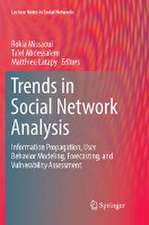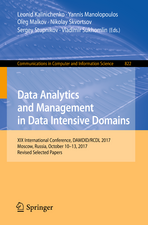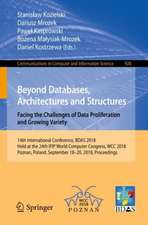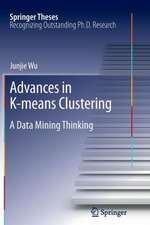The 3-D Global Spatial Data Model: Principles and Applications, Second Edition
Autor Earl F. Burkholderen Limba Engleză Paperback – 30 sep 2020
| Toate formatele și edițiile | Preț | Express |
|---|---|---|
| Paperback (1) | 346.65 lei 3-5 săpt. | +28.25 lei 6-12 zile |
| CRC Press – 30 sep 2020 | 346.65 lei 3-5 săpt. | +28.25 lei 6-12 zile |
| Hardback (1) | 1117.57 lei 6-8 săpt. | |
| CRC Press – 24 iul 2017 | 1117.57 lei 6-8 săpt. |
Preț: 346.65 lei
Preț vechi: 433.31 lei
-20% Nou
Puncte Express: 520
Preț estimativ în valută:
66.33€ • 69.12$ • 54.92£
66.33€ • 69.12$ • 54.92£
Carte disponibilă
Livrare economică 13-27 martie
Livrare express 26 februarie-04 martie pentru 38.24 lei
Preluare comenzi: 021 569.72.76
Specificații
ISBN-13: 9780367872991
ISBN-10: 0367872994
Pagini: 528
Dimensiuni: 156 x 234 x 30 mm
Greutate: 0.73 kg
Ediția:2 New edition
Editura: CRC Press
Colecția CRC Press
ISBN-10: 0367872994
Pagini: 528
Dimensiuni: 156 x 234 x 30 mm
Greutate: 0.73 kg
Ediția:2 New edition
Editura: CRC Press
Colecția CRC Press
Public țintă
Professional Practice & DevelopmentCuprins
Foreword. Preface to the Second Edition. Preface to the First Edition. Acknowledgments. Author. List of Abbreviations. Chapter 1 The Global Spatial Data Model (GSDM) Defined. Chapter 2 Featuring the 3-D Global Spatial Data Model. Chapter 3 Spatial Data and the Science of Measurement. Chapter 4 Summary of Mathematical Concepts. Chapter 5 Geometrical Models for Spatial Data Computations. Chapter 6 Overview of Geodesy. Chapter 7 Geometrical Geodesy. Chapter 8 Geodetic Datums, Chapter 9 Physical Geodesy. Chapter 10 Satellite Geodesy and Global Navigation Satellite Systems. Chapter 11 Map Projections and State Plane Coordinates. Chapter 12 Spatial Data Accuracy. Chapter 13 Using the GSDM to Compute a Linear Least Squares GNSS Network. Chapter 14 Computing Network Accuracy and Local Accuracy Using the Global Spatial Data Model. Chapter 15 Using the GSDM—Projects and Applications. Appendix A: Rotation Matrix Derivation. Appendix B: 1983 State Plane Coordinate Zone Constants. Appendix C: 3-D Inverse with Statistics. Appendix D: Development of the Global Spatial Data Model (GSDM). Appendix E: Evolution of Meaning for Terms: Network Accuracy and Local Accuracy. Index.
Notă biografică
A native Virginian, Earl F. Burkholder grew up in Virginia’s Shenandoah Valley and graduated from Eastern Mennonite High School in 1964. He earned a BS in civil engineering from the University of Michigan, Ann Arbor, Michigan, in 1973 and an MS in civil engineering (Geodesy) in 1980. From 1980 to 1993, he taught upper division surveying classes at the Oregon Institute of Technology, Klamath Falls, Oregon. After five years of being self-employed, he taught in the Surveying Engineering program at New Mexico State University from 1998 to his retirement in 2010. His professional career began as a draftsman with Gould Engineering, Inc. of Flint, Michigan in 1968. Following graduating from University of Michigan, Ann Arbor, Michigan, he worked five years for Commonwealth Associates, Inc. of Jackson, Michigan, an international consulting firm for the utility industry. Assigned to the Transmission Line Engineering Division at Commonwealth, he was responsible for surveying related computations on projects in numerous states and was promoted to Survey Project Manager prior to leaving in 1978 to attend Purdue University. While teaching at Oregon Tech, he became editor of the ASCE Journal of Surveying Engineering and served two separate four-year terms; 1985–1989 and 1993–1998. He also became involved in ABET accreditation activities while at Oregon Tech and went on to serve on the Engineering Related Accreditation Commission (now known as the Applied Science Accreditation Commission) culminating as chair of the RAC in 2000/2001.
While self-employed, he completed three major projects for the Southeastern Wisconsin Regional Planning Commission (SEWRPC), Waukesha, Wisconsin. The first project was to develop a reliable bidirectional algorithm for transforming data between the NAD 27 datum being used by SEWRPC and the new NAD 83 datum published by the National Geodetic Survey (NGS). Upon successful completion of the horizontal transformation
While self-employed, he completed three major projects for the Southeastern Wisconsin Regional Planning Commission (SEWRPC), Waukesha, Wisconsin. The first project was to develop a reliable bidirectional algorithm for transforming data between the NAD 27 datum being used by SEWRPC and the new NAD 83 datum published by the National Geodetic Survey (NGS). Upon successful completion of the horizontal transformation
Recenzii
"As a practicing surveyor responsible for producing 3D geodetic survey control to establish and define the NSRS relationship on large transportation and infrastructure projects involving cutting edge state of the art geospatial technology such as Mobile Lidar and UAV Lidar / Imagery Acquisition, I am utterly astounded that we are still working in the dark ages using State Plane Coordinates, and so dissatisfied with the outcome, we scale them back to the ground where we made the measurements in the first place. Seriously, how much longer must we endure the Grid vs. Ground non-solution? How many more classes and workshops on Grid vs. Ground must there be? A better solution, the LDP still lingers with only some limited examples of implementation. With the problems caused by the improper use of the SPCS over the past several decades, it is unlikely that a more sophisticated solution like the LDP will replace the former. The NSRS will be redefined shortly, only a few years away, including a new gravimetric vertical datum. The time for the GSDM is here right now. Read this book today. Become an advocate and a voice promoting the GSDM. Your children will thank you for it and your grandchildren will remember you for it."
—Jesse Kozlowski, Geodetic Surveyor, Maser Consulting, Philadelphia, Pennsylvania, USA
"The 3-D Global Spatial Data Model: Principles and Applications, 2nd Edition is remarkable in its complete and comprehensive treatment of the geocentric Cartesian coordinate system, which is the basis for modern geomatics. Earl Burkholder has delved deeply into every aspect of this coordinate system and used it to produce a unified approach to handling all aspects of geospatial data. The book is essentially self-contained, including fundamentals such as number systems, logic, arithmetic, algebra, and geometry; plus more advanced topics in geometric geodesy, physical geodesy, and error theory. The treatment includes worked examples so it is accessible
—Jesse Kozlowski, Geodetic Surveyor, Maser Consulting, Philadelphia, Pennsylvania, USA
"The 3-D Global Spatial Data Model: Principles and Applications, 2nd Edition is remarkable in its complete and comprehensive treatment of the geocentric Cartesian coordinate system, which is the basis for modern geomatics. Earl Burkholder has delved deeply into every aspect of this coordinate system and used it to produce a unified approach to handling all aspects of geospatial data. The book is essentially self-contained, including fundamentals such as number systems, logic, arithmetic, algebra, and geometry; plus more advanced topics in geometric geodesy, physical geodesy, and error theory. The treatment includes worked examples so it is accessible
Descriere
This new second edition demystifies the concepts of spatial data accuracy and provides mathematical clarity to issues of network accuracy and local accuracy. Ideal for both beginner and advanced levels, this book also provides guidance and insight on how to link to the data collected and stored in legacy systems.























